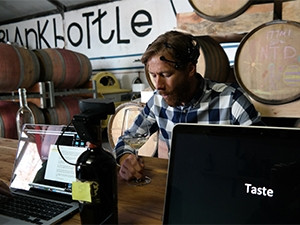
A South African team of neuromarketers and neuroscientists created the world's first NeuroWine, a wine that was developed by taking the tools and technologies that are traditionally used in neuroscience and applying them to the art of wine-making.
Neural Sense, a local neuromarketing consultancy, partnered with Pieter Walser, a Cape wine maker from the BLANKBottle label. Using neuroscience and biometric technologies, they tested 21 different white wine and 20 different red wine varietals from a number of different vineyards across the country.
They assessed Walser's emotional and cognitive responses to each testing experience to create the world's first NeuroWine, available in red and white.
The team uses neuroscience technologies such as electroencephalography to measure brain response and galvanic skin response biometric sensors to measure changes in one's physiological state to learn why consumers make the decisions they do, and how to optimise the emotional drivers behind these decisions.
They also investigate the specific emotions experienced at particular moments in time through facial coding and identify specific visual influencers with eye-tracking technologies.
"One of the pieces of technology we used - known as electroencephalography - is a device which fits around the head and picks up the electrical activity on the surface of one's scalp," explains Dr David Rosenstein, from Neural Sense.
"It looks at how the brain is functioning and the associated brain waves, which in turn tells us various things about brain activity. Back in our laboratory, we built a model of Pieter's brain activity and together with the other biometric data, we were able to uncover his unconscious responses to the wine tasting experience.
"This model enabled us to determine what were the best performing aspects of the various varietals he was tasting, and identify the top wine varietals that his unconscious appealed to, together with his subjective reporting, to form the NeuroWine blends as our ultimate goal."
Walser admits he sometimes struggles to make his blends due to his own preconceptions of what the wine should taste like given his knowledge of the vineyards from which the grapes are sourced.
"I make about a total combination of 27 different varietals and I own no land, but I rent vineyards all over the Western Cape," says Walser.
"I look at soil, climate and topography, and then I look at whatever grows best at each specific site. The day I pick them, I taste the grapes and I decide more or less what the wine's going to be like, but it then goes through different phases during the winemaking process so by the time I need to bottle - which is fairly soon - I can become confused. However, this neuromarketing approach has allowed my subconscious, and not my conscious, to do the talking."
Mark Drummond from Neural Sense adds: "Our job, as neuroscientists and neuromarketers, is to build an understanding of how people experience things and that could be the taste of a wine or it could even be the experience of looking at a wine label or bottle shape.
"Using neuromarketing techniques and technologies, we are able to explore the subconscious and the underlying emotional drivers that drive decision-making. This allows us to see into the hearts and minds of consumers, or winemakers in this case, giving us new insight into their experiences which can then be optimised."
NeuroWine will be launched in May and will be available through Woolworths as both a red and a white wine varietal. Pricing details are still to be disclosed.
Share